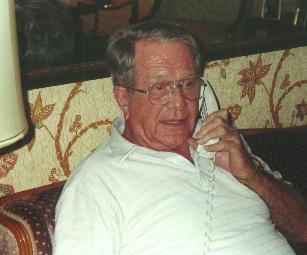Walter Hau t, the man who issued the press release that claimed the Army had recovered a flying saucer died Thursday, December 15, 2005. He was 83 according to published reports.
t, the man who issued the press release that claimed the Army had recovered a flying saucer died Thursday, December 15, 2005. He was 83 according to published reports.
 t, the man who issued the press release that claimed the Army had recovered a flying saucer died Thursday, December 15, 2005. He was 83 according to published reports.
t, the man who issued the press release that claimed the Army had recovered a flying saucer died Thursday, December 15, 2005. He was 83 according to published reports.Haut, it might be said, was the father of the Roswell UFO crash story. He was the man who gave the interviews, provided leads, and always seemed to have a new idea when the old began to fade. He was the link to Glenn Dennis, the mortician who reported bodies at a Roswell funeral home; to Frank Kaufmann, who claimed to have been an intelligence agent in Roswell and one of the creators of the cover up; and the man who conceived the International UFO Museum and Research Center for Roswell.
Haut will be best remembered as the man told the world about the Roswell flying saucer. In later years he would confess that he no longer remembered if Colonel William Blanchard, the commander of the bomb group in Roswell, had called him with the specifics of the crash, had called with an already completed press release, or if Blanchard had ordered him to report in person. No matter which it was, Haut took the completed press release to the four media outlets in Roswell, the two daily newspapers and the two radio stations, and then went home. He told Russ Estes that he mowed the lawn.
There was, for several hours, a firestorm around Roswell. Haut said that he got telephone calls from around the world, and at one time had a stack of envelopes and stamps from nearly every foreign nation. Although he had reported the debris found was from a flying saucer, the Army later said that it was from a secret balloon project. As that story took over, the phone calls dwindled.
Haut told most researchers that his only involvement had been to write the press release. He hadn’t seen anything else personally, but he believed that the debris came from an alien spacecraft.
Although the details he provided were sometimes confused, the overall story he told remained the same for nearly twenty years. The Army had recovered one of the flying saucers, sent it on to higher headquarters, and then those in Roswell had gone back to work.
In the mid-1990s, Haut began to hint that he might have seen more than he had said originally. He had told me, repeatedly, that his only role was as author of the press release. He had attended staff meetings. In one of them Colonel Blanchard made it clear that they had found a weather balloon and no one was to talk about it again.
Stories began to circulate that Haut was closer to the inside than he had let on. In a video-taped interview conducted by New Mexico UFO researchers, Haut said he had seen the craft and the bodies. That information was not to be released until his death.
Haut, with friends Glenn Dennis and Max Littell, started the International UFO Museum in 1991. He was president until 1996. Littell died several years ago. Of those three, only Dennis remains.
Haut was born June 3, 1922, in Chicago. He had trained during World War II as both a navigator and a bo
 mbardier. He served in the Pacific during the war and later, in 1946, participated in Operation Crossroads, the atomic tests at Bikini. He had been assigned to the 509th Bomb Group on temporary duty for the atomic tests, but that duty was expanded into a permanent assignment. In July 1947, he was a first lieutenant and worked as the Public Information Officer for the bomb group. He left the service the next year and remained in Roswell for the rest of his life.
mbardier. He served in the Pacific during the war and later, in 1946, participated in Operation Crossroads, the atomic tests at Bikini. He had been assigned to the 509th Bomb Group on temporary duty for the atomic tests, but that duty was expanded into a permanent assignment. In July 1947, he was a first lieutenant and worked as the Public Information Officer for the bomb group. He left the service the next year and remained in Roswell for the rest of his life.Haut was one of the main reasons that the Roswell case achieved international attention. He was well spoken, sometimes funny and always articulate. He provided information to all who asked for it, was courteous to the hundreds of people who showed up at his front door over the last two and a half decades, and who enjoyed his role as "Mr. UFO." With his passing, one of the pillars of the Roswell UFO crash has been lost.




















